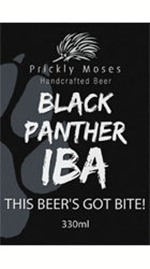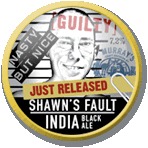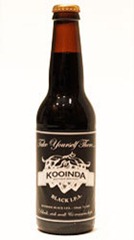
Take me out black
It’s a hard style to talk about definitively. There’s debate over what it should be called—Black India Pale Ale, India Black Ale, Cascadian Dark Ale, American Black Ale, et al.—and there’s question around how exactly to define it. Is it a highly-hopped Porter or is it an India Pale Ale with a smattering of roasted malt?
‘Black IPA’ has seemingly become the most common name for the style, but some brewers are preferring to refer to it as an ‘IBA’ (‘India Black Ale’). This is understandable when you consider the I.P.A. acronym translates to India Pale Ale, something contradictory to the preceding adjective. Black and pale. Does not compute.
This is of course something more specific than the standard pale ale confusion. Pale ale has historically been used to identify any ale paler—even amber and beyond—than the porter. But this new style is as dark as a Porter, but has also evolved from the pale ale lineage.
It’s a fairly recent style, having only been brewed for the first time in the late 1980s or early 1990s. It is generally attributed to the late Greg Noonan of Vermont Pub and Brewery in Vermont, USA, but again, there is debate.
Perhaps we’ll begin dispensing with pigeonholing. It’s an ale. It’s characterised by its light-shall-not-pass black hue, its roasted malt character, and high hopping.
And with much respect to Mr Noonan, let us also disabuse ourselves of any notion that we may determine conclusively where and by whom the first example of the style was brewed. Or at least agree that it is not within the scope of this writing. Indeed, you might even say it was a style that was bound to happen, and maybe even happened in multiple places at once.
So why talk about it now? Well, within the past year or so, Australia has seen more than a few breweries brewing and releasing a rendition of this beer, where previously you may have been hard-pressed to find an Australian beer lover who even knew it existed.
 Luke Scott, head brewer at Otway Estate, and who refers to the style as an ‘American IBA,’ said their decision to brew the style, now released in bottled form as the Prickly Moses Black Panther IBA, came two-fold.
Luke Scott, head brewer at Otway Estate, and who refers to the style as an ‘American IBA,’ said their decision to brew the style, now released in bottled form as the Prickly Moses Black Panther IBA, came two-fold.
“We wanted to do either an Imperial Stout or this. Something big,” he said, and the IBA was decided upon to fill the requirement of an exclusive brew for the Young & Jackson hotel in Melbourne.
“I wasn’t aware too much of the style at the time. It really came from [Otway brewer Steve Henderson].”
But it was Scott who brewed the first batch to Henderson’s recipe, based predominantly around hops sourced from Oregon in the United States, and it was creatively successful enough to warrant bottling.
As for why he believes the IBA style is taking off, Scott suggests a form of natural progression.
“I think it’s a manifestation of people’s alpha addiction,” he suggested.
But he also mentioned the growing push among Australian brewers to experiment.
“I think Australian brewers are starting to push the boundaries,” he said, echoing the craft brewing scene in the United States.
Dave Bonighton, co-founder and chief brewer at Mountain Goat, echoed the sentiment.
“I think it’s just that Australian brewers are, by nature, experimental. If something new happens, we have to be a part of it,” he said, adding, “Next year it’ll be something else.” Is he suggesting that the style is merely a fleeting flirtation, or is it more likely his point was that a brewer’s attention by nature is easily diverted to the next challenge.
Bonighton recalls first learning about the style.
“We’d made a couple of IPAs, including a double-IPA, and as soon as I heard of ‘Black IPA,’ it seemed like such a natural thing. I wondered why I hadn’t thought of it.”
Mountain Goat’s interpretation, a collaboration with Thornbridge Brewery in the UK called The Thorny Goat, was envisioned as a southern-hemisphere version of Thornbridge’s Raven Black IPA using southern-hemisphere hops like Cascade and Nelson Sauvin. But Bonighton stresses that although that was how it was envisioned, “It’s not meant to be a definitive version.”
 At Murray’s Brewing Company, head brewer Shawn Sherlock recalls his process as having much less of a mission statement.
At Murray’s Brewing Company, head brewer Shawn Sherlock recalls his process as having much less of a mission statement.
“There’s really no long-winded story behind it. I was looking online, and there was a reference to a ‘Black IPA.’ It struck a chord.”
Indeed, the evolution of Murray’s Shawn’s Fault India Black Ale was, as suggested by the name, a more personal exploration. It began four or five years ago, after that chord had been struck, when Sherlock began to brew some home batches to his own taste.
“I’d never even tasted one until I brewed one,” he said.
“It’s really to suit my palate.”
And when asked for ideas for Murray’s ‘monthly special,’ Sherlock’s suggestion was memorable.
“I said, ‘So. Got this idea. This is how it’s gonna taste. It’s something [where] people are gonna love it or they’re gonna hate it.’”
The final result was released in draught form as Murray’s February special of 2010, and represents the first example of the style in Australia to be brewed by a commercial brewery (to the best of all currently available knowledge).
As to why the style may be taking off, Sherlock offers, “I think there’s a lot of interest in IPAs as a style, and I think as it’s starting to settle into a style, people are looking for more interesting variations.”
 Like Sherlock, Mick Opie, brewer at Kooinda Boutique Brewery, was brewing the style for a while before the brewery decided to make it a commercial release.
Like Sherlock, Mick Opie, brewer at Kooinda Boutique Brewery, was brewing the style for a while before the brewery decided to make it a commercial release.
“We’d started playing with it ages ago, darkening up some IPAs.”
“I’ve been collecting [Brew Your Own] magazine for years. I’ve got hundreds of them, and it was in there years ago. It was called ‘Cascadian Dark Ale.’ But I guess there just wasn’t a market for it back then.”
But Opie was excited to discover other brewers were brewing the style.
“We went to Mountain Goat, actually, to buy their bottling machine. They were brewing a batch and we said, ‘They’ve done one!’ And now everyone’s followed each other.”
And despite this seeming chain-reaction of brewers brewing the style, there is still a good deal of variation within the examples of this beer coming from Australian breweries.
The Prickly Moses Black Panther clearly focuses on the style’s American roots, while The Thorny Goat and Kooinda’s Full Nelson Black IPA, which was brewed using only the Nelson Sauvin hop variety at its various stages, are specific attempts at a local adaptation. Murray’s Shawn’s Fault we learn is the fanciful exploration of its brewer, and this now brings us to Red Hill Brewery’s Red Hill IBA.
“Most of our beer here is a bit less intense, a bit softer, more traditional,” says Red Hill Brewery head brewer and co-owner Dave Golding.
“[Our IBA is] based more around an English IPA; slightly less full on.”
The process of Red Hill’s IBA began when brewer Simon Bardill travelled to England around eighteen months ago and discovered the style.
“[Simon] was raving about this style. And at the same time, we’d visited Bridge Road in Beechworth and had the B2 Bomber, which was one of our favourites of the year,” Golding recalls.,It was around this time he decided to try something different.
“Everything’s usually to my recipe, but I decided to give the brewers free reign. I said, ‘You guys decide what style you want to do and we’ll put it on tap at the brewery.’”
Bardill and Red Hill’s other brewer, Tim Cabelka, spent the next month or two brewing batches on their home systems, picking them apart with Golding to arrive at the final product.
“I think it’s worked really well. The punters have really liked it, and I think it really works for the time of year and the temperature range,” Golding says.
Of the style’s attraction, Golding says, “At the moment, everyone wants different and unusual, and that’s an IBA.”
“It’s quite an interesting style. It tricks you. Your brain expects a certain thing because of how it looks, but you close your eyes and drink, and it tastes just like an IPA.”
So how do we explain the emergence of this style in Australia? You mean beyond merely enjoying the fact that the style has made it to Australia and is seeing more than a few local releases?
Well, if a comparison is to be drawn between the state of the craft-brewing scene in Australia and the boundary-pushing American scene, the argument can be made that there would certainly be an attraction to this American-born style. The Australian brewers, in their inquisitive nature, always searching for new styles to try, appear to have also taken to the style quite simply because it’s a good idea, a natural progression of the popular India Pale Ale. So it doesn’t appear to be all Shawn’s fault. It’s probably something that was just bound to happen.
But what of its future?
Opie, after discussing the style’s matching to the wintry months of the year, quite rightly poses the question, “Is it going to last through summer?”
This style, although fairly new in the grand scheme of things, has existed as an exciting prospect to some brewers for years. Sherlock and Opie in particular had been brewing the style at home for around five years, and it would be a mistake to be dismissive of its longevity beneath the radar and expect that it will just fade away now that it has appeared at the commercial level.
But it is of course a seasonal beer better suited to the colder stretch of months and we’ll probably have to wait until this time next year to know for sure if the style will be a mainstay. And it will essentially come down to the consumer to determine whether the brew can exist as a financially-viable regular or seasonal regular.
At least for the next year or so, we can surely enjoy what has been released so far, we can expect comfortably that some other breweries will release a version for the first time, and maybe we’ll start to see some breweries push the style even further, to Imperial and barrel-aged heights and beyond.
The bottle has been opened.
Australia’s Black IPAs/IBAs
- Murray’s Brewing Company’s Shawn’s Fault India Black Ale was Australia’s first commercially-released ‘India Black Ale.’ It has been bottled for the first time this month and can be found at good beer stores or from the Murray’s website.
- Bridge Road Brewery’s B2 Bomber was the result of blending the brewery’s Galaxy IPA and Robust Porter. It utilised a Belgian yeast strain and was released as their fifth-year anniversary ale.
- Mountain Goat/Thornbridge Brewery’s The Thorny Goat was the first commercially-released collaborative brew from an Australian brewery.
- The Red Hill IBA has a more subdued roasted malt character than others, especially from the hand-pump. You can find it at the brewery or, with luck, on tap at good beer venues.
- Kooinda Boutique Brewery’s Full Nelson Black IPA was brewed solely with Nelson Sauvin hops. Initial batches ranged between 90 and 100 IBUs, but the final landed just a notch above 70. You can find it in good beer stores.
- Otway Estate’s Prickly Moses Black Panther IBA definitely feeds the alpha addiction, which head brewer Luke Scott approximated at 75 IBUs. It’s available in good beer stores or from the Prickly Moses website.
The author would also like to recommend New Zealand’s Yeastie Boys’ Pot Kettle Black for another fine southern-hemisphere rendition of the style. He would also like to thank the breweries for their time and for humouring him on his first rodeo.
[adrotate group=”1″]




